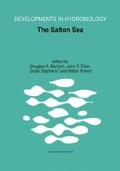Abstract
The Salton Sea, the largest ‘man-made’ water body wholly within California, was formed in 1904 as the result of a levee failure along the Colorado River. Initially, flow into the Salton ‘Sink’ created a fresh water lake about 24 m deep with a water surface about 85 m below the level of the ocean. Salinity of the water body, at first roughly the same as the river, rose rapidly due to solution of previously accumulated residual salt, then following levee repair, adjusted to the combined influence of agricultural drainage accretions and evaporative losses. Water levels adjusted accordingly, at first declining then rising slowly until the mid 1930s when a level about 75 m below ocean level was reached. Thereafter, both water levels and salinity gradually rose, so that at present the surface elevation of the Sea stands near −69.5 m and salinity is approaching 45 g 1−1, about 30% above ocean salinity. The Salton Se: Authority is seeking practical methods for reducing water levels and controlling salinity within ranges that will protect beneficial uses of the Sea, its adjacent lands, and its indigenous ecosystems, both aquatic and avian. Pro posed solutions include various physical changes in the bathymetry and configuration of the Sea, especially its southern basin. Because circulation in the Sea is driven primarily by wind stresses imposed on the water surface, and circulation changes are likely to affect the Sea’s quality and ecology, a methodology for quantifying the effects of specific alternatives is required. For this purpose a mathematical model for simulation of the hydrodynamic behavior of the Sea has been developed, calibrated to data gathered by a field investigation conducted in 1997, and applied to alternative schemes that will isolate sections of the southern basin, thus changing the natural wind induced circulation in areas that are ecologically sensitive. The Salton Sea Hydrodynamic/Water Quality Model is constructed using the finite element method to represent the bathymetry of the Sea as it currently exists, or may subsequently be modified, in a three-dimensional grid. Given certain boundary conditions, for example wind stresses imposed on the surface, the model solves the three dimensional equations of motion and continuity, the advection—dispersion equation, and an equation of state dependent upon temperature and salinity, to obtain temporal and spatial descriptions of velocities and temperatures over a specified period of time. Using data derived from 1997 field measurements of velocities using acoustic Doppler current profilers and temperature sensors, the model was calibrated to reproduce mathematically the historic experience of field observation. The model successfully replicated principal features of the Sea’s behavior, especially the persistence of a counterclockwise gyre in the southern basin and seasonal stratification. Once calibrated, the model was applied to evaluate the possible effects of changing water surface elevations in the Sea and altering its configuration to isolate sections for evaporative concentration of salts. These effects, evident in changes in velocity, were quantified with regard to their possible impacts on the aquatic habitat and the health of the Salton Sea ecology. A comparative evaluation of alternatives is presented.
Access this chapter
Tax calculation will be finalised at checkout
Purchases are for personal use only
Preview
Unable to display preview. Download preview PDF.
References
Barnes, S., 1964. A technique for maximizing details in numerical weather map analysis. J. appl. Meteorol. 3: 396–409.
Cook, C. B., 2000. Internal dynamics of a terminal basin lake: a numerical model for management of the Salton Sea. Ph.D. Dissertation, Dept. of Civil, Env. Engr., Univ. of Ca.-Davis.
Henderson-Sellers, B., 1982. A simple formula for vertical eddy diffusion coefficients under conditions of nonneutral stability. J. Geophys. Res. 87 (C8): 5860–5864.
Huston, D. W., 2000. Application of a wind field analysis to a three-dimensional hydrodynamic model of the Salton Sea, California. M.S. Thesis, Dept. of Civil, Env. Engr., Univ. of Ca.-Davis.
Huston D. W., C. B. Cook, G. T. Orlob, 1999. New and Alamo Rivers Project: Preliminary Data Collection and Analysis for Development of Hydrodynamic and Water Quality River Models, Report 99–3, Water Res., Env. Modeling Group, Ctr. for Env., Water Res. Engr., Univ. of Ca.-Davis.
King, I. P., 1985. Strategies for finite element modelling of three dimensional hydrodynamic systems. Adv. Wat. Res. 8: 69–76.
King, I. P., 1993. A finite element model for three-dimensional density stratified flow. Australian Water and Coastal Studies Report, April.
Lesieur, M., O. Metais, 1996. New trends in large-eddy simulations of turbulence. Ann. Rev. Fluid Mech. 28: 45–82.
Mellor, G., T. Yamada, 1974. A hierarchy of turbulence closure models for planetary boundary layers. J. Atmosph. Sci. 31: 1791–1482.
Mellor, G., T. Yamada, 1982. Development of a turbulence closure model for geophysical fluid problems. Rev. Geophy. Space Phys. 20 (4): 851–875.
Tennessee Valley Authority, 1972. Heat and Mass Transfer Between A Water Surface and the Atmosphere, Water Res. Research, Engr. Lab., Rep. No. 14, April.
Tostrud, M., 1997. The Salton Sea 1906–1996 Computed and Measured Salinities and Water Levels, Colorado River Board of California, California Resources Agency.
Author information
Authors and Affiliations
Editor information
Editors and Affiliations
Rights and permissions
Copyright information
© 2002 Springer Science+Business Media Dordrecht
About this chapter
Cite this chapter
Cook, C.B., Orlob, G.T., Huston, D.W. (2002). Simulation of wind-driven circulation in the Salton Sea: implications for indigenous ecosystems. In: Barnum, D.A., Elder, J.F., Stephens, D., Friend, M. (eds) The Salton Sea. Developments in Hydrobiology, vol 161. Springer, Dordrecht. https://doi.org/10.1007/978-94-017-3459-2_5
Download citation
DOI: https://doi.org/10.1007/978-94-017-3459-2_5
Publisher Name: Springer, Dordrecht
Print ISBN: 978-90-481-5989-5
Online ISBN: 978-94-017-3459-2
eBook Packages: Springer Book Archive

